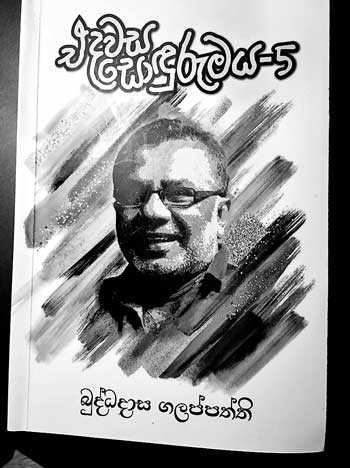Thursday Dec 12, 2024
Thursday Dec 12, 2024
Saturday, 4 May 2019 00:00 - - {{hitsCtrl.values.hits}}
 As newspaper readers we enjoy reading regular columns by writers, particularly if they are well written and cover interesting topics. Some are even tempted to cut and collect the ones he or she likes. Most of us don’t have the patience to do that unlike the days when as school children we collected articles which we liked. Of course, then the craze was to collect cricket pictures.
As newspaper readers we enjoy reading regular columns by writers, particularly if they are well written and cover interesting topics. Some are even tempted to cut and collect the ones he or she likes. Most of us don’t have the patience to do that unlike the days when as school children we collected articles which we liked. Of course, then the craze was to collect cricket pictures.
With the internet and YouTube, collecting articles is a thing of the past since one is able to refer to an article so long as he or she can roughly remember the dates or even months.
Poet turned newspaper columnist Buddhadasa Galapppatty obviously knows that there are readers who have got addicted to his writing. A few years back he tried his hand in selecting some of his columns written under a particular title and printing in book form. Its success led him to release a selected lot once in two years or so.
Buddhi recently released the fifth collection from his weekly column that appears every Tuesday in the ‘Dinamina’. He ensures that it’s an attractive print job neatly done on quality paper that makes the reader happy to read it. He uses a picture relevant to the subject he discusses and devotes a page for the picture and the subject title.
The latest release titled ‘Edawasa Sondurumaya – 5’ comprises 36 columns he has contributed between July 2017 and August 2018.
A feature of his selections is the accent on personalities. They are an assorted lot but with his interest in the arts the bias is on those involved in writing, acting and singing. He has thrown in a couple of human interest stories as well involving people of other vocations.
Buddhi’s cleverness is to start a column in a manner where the reader gets hitched on straightaway. Sometimes the reader begins to wonder whether he is drifting away from the main theme of the article. Because of his writing style the reader gets engrossed and continues to read.
He has the knack of picking an interesting story he had read about, heard or seen on TV and highlight the personality involved.
In writing the story of High Court Judge Manikkavasagar Ilalncheniyan whose life was saved by his bodyguard near the Nallur kovil in Jaffna, police sergeant G M Sarath Hemachandra who was shot at (he later died), Buddhi describes how the judge wept before Hemachandra’s wife and later at the funeral announced that he would take charge to educate the two children. He knew his bodyguard died in an effort to save his (judge’s) life.
Buddhi discusses the human qualities of both the sergeant and the judge who, irrespective of what clan or creed they belonged to, rose up to face the situation – one to save his master and the other to help the family who became helpless after the incident.
Buddhi brings back memories on many artistes for their contribution to the arts. Some, like Ediriweera Sarachcandra, Lester James Peries, Sugathapala de Silva, Bandula Jayawardena,  Dharmasena Pathiraja, Somaweera Senanayake, Karunasena Jayalath and Hema Nalin Karunaratne are no more. Many of the others are either active or fairly silent.
Dharmasena Pathiraja, Somaweera Senanayake, Karunasena Jayalath and Hema Nalin Karunaratne are no more. Many of the others are either active or fairly silent.
Buddhi’s book helped me to recall some of the contacts I made when I was handling the Arts column in the Sunday Observer. Meeting the successful artistes of that golden era was indeed a most satisfying experience. Most of them were introduced to the English readers through the Arts column and we were able to create a new audience for Sinhala theatre, cinema and music.
To give an example: Chandrasoma Dasaanayake, then a novice created ‘Rankanda’ (1970) – drama based on My Fair Lady – which became an instant hit. It was only when I read Buddhi’s article about him that I realised that leading players of the day – Upali Attanayake, Mercy Edirisinghe, Vijaya Nandasiri, Daya Alwis, Quintus Weerakoon as well as music director Austin Munasinghe, stage décor and make-up artiste Gamini Wickremasuriya are no more. I recall making contact with him when he produced the award-winning schools drama, ‘Aandi tikai ambalamai’ with the Vidyaratne children.
It was nice reading about the recognition of ‘Pothe Guru’ Wijeratne Warakagoda at the 2018 Raigam Tele Awards where he was given the once a lifetime Achievement Award. The same year he won the ‘Natya Kirti’ State award given once a lifetime at the State Drama Festival. Buddhi wonders why ‘Waraks’ – as we fondly calls him, has not been recommended for a Guinness world record for rendering his voice without a break for over half a century since April 1964 as Korale Mahattaya, the lead role in the popular radio play, Mudalinayaka Somaratne’s ‘Muwan Pelessa’.
Buddhi writes about the value of the Punchi Theatre in the heart of Borella and praises the effort of the Namel/Malani Weeramuni duo.
This is just a glimpse of Buddhi’s collection. There are many more which the reader will enjoy.